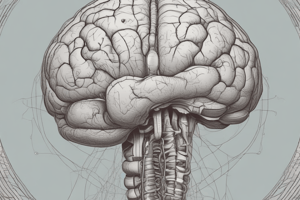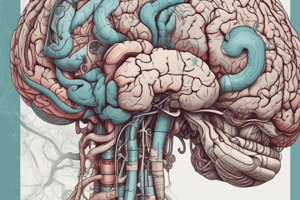Podcast
Questions and Answers
What is the main function of the grey matter in the cerebellum?
What is the main function of the grey matter in the cerebellum?
- To process and integrate sensory information (correct)
- To facilitate the morphological divisions of the cerebellum
- To develop the functional connections of the cerebellum
- To regulate the blood supply to the cerebellum
Which of the following is NOT a morphological division of the cerebellum?
Which of the following is NOT a morphological division of the cerebellum?
- Flocculonodular lobe
- Posterior lobe
- Anterior lobe
- Cerebral cortex (correct)
What is the primary function of the cerebellum in relation to movement?
What is the primary function of the cerebellum in relation to movement?
- To control the speed of movement
- To regulate the coordination and balance of movement (correct)
- To initiate movement
- To terminate movement
Which of the following is a functional division of the cerebellum?
Which of the following is a functional division of the cerebellum?
What is the main function of the blood supply to the cerebellum?
What is the main function of the blood supply to the cerebellum?
What is the clinical significance of understanding the cerebellum's anatomy?
What is the clinical significance of understanding the cerebellum's anatomy?
Flashcards are hidden until you start studying
Study Notes
Cerebellum
- Located in the lower part of the brain, above the brain stem
- Divided into two hemispheres: left and right
External Features
- Cerebellum has a wrinkled surface, with grooves and fissures
- Divided into lobes, fissures, and sulci
Parts of Cerebellum
- Vermis: a narrow, worm-like structure connecting the two hemispheres
- Hemispheres: divided into anterior and posterior lobes
Morphological Divisions of Cerebellum
- Anterior lobe: consists of three parts - central, intermediate, and lateral
- Posterior lobe: consists of pyramis, uvula, and tuber
Functional Divisions of Cerebellum
- Spinocerebellum: receives sensory information from the spinal cord
- Pontocerebellum: receives information from the pons
- Cerebrocerebellum: receives information from the cerebral cortex
Connections of Cerebellum
- Receives information from sensory receptors, spinal cord, and brain stem
- Sends information to the thalamus, red nucleus, and other brain structures
Grey Matter of Cerebellum
- Consists of an outer grey layer (cerebellar cortex) and inner white matter
- Grey matter contains Purkinje cells, granule cells, and interneurons
Blood Supply
- Cerebellum receives blood from the vertebral and basilar arteries
Functions of Cerebellum
- Coordinates voluntary movements, balance, and posture
- Regulates muscle tone and maintains equilibrium
- Helps in learning and remembering motor skills
Studying That Suits You
Use AI to generate personalized quizzes and flashcards to suit your learning preferences.




